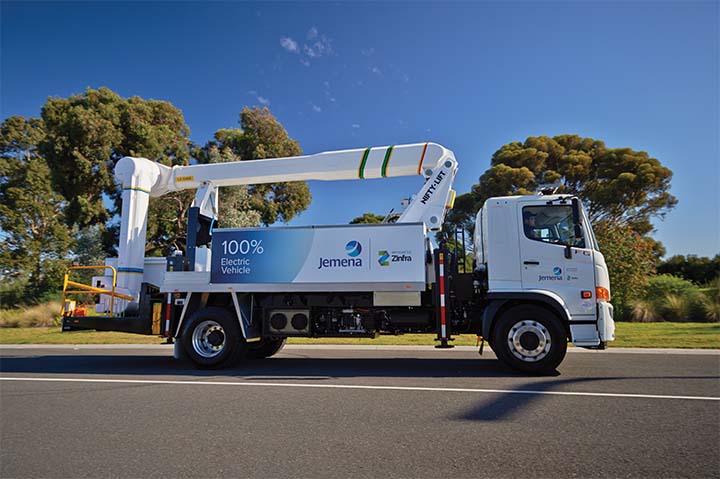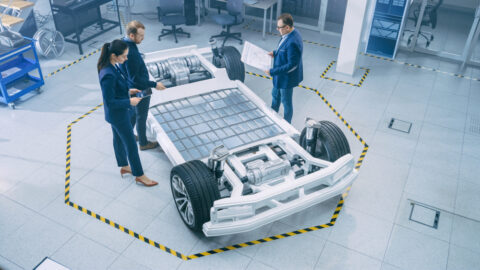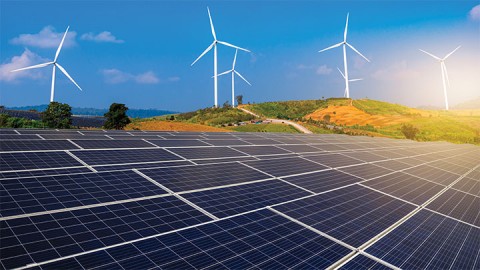Jemena and Zinfra expanded their Victorian fleet in August with the unveiling of an Australian-first electric-powered elevated work platform – colloquially known as a cherry picker – truck to perform upgrades and repairs on the Jemena Electricity Network in Melbourne’s north-west.
The fully electric elevated work platform (EWP) truck was launched as part of an effort to reduce carbon emissions across the Jemena Electricity Network, by reducing Jemena’s carbon output by 30 tonnes per year.
This is in addition to other energy efficient initiatives already rolled out within the network, including the installation of 500 LED ‘smart street lights’ that use up to 75 per cent less energy than traditional lighting.
Jemena delivers electricity to more than 360,000 homes and businesses in Melbourne’s north-west, while Zinfra performs maintenance and operations services to the network.
The electric EWP truck was a joint initiative for the companies, which are both owned by SGSP (Australia) Assets Pty Ltd.
Bringing the vehicle to life
Many businesses across Australia have already begun moving towards an electric vehicle fleet due to the savings that can be achieved on diesel, servicing and maintenance, as well as the significant benefit of lowering carbon emissions.
For energy companies that use larger vehicles, like EWPs, the process of moving towards an electric-powered fleet can be a bigger challenge.
For Jemena and Zinfra, bringing the electric EWP truck to life was a complex process that took over two years. The team knew many complexities would be involved, but after discussions with Australian automotive technology company SEA Electric and Victorian elevated work platform design and manufacturing company Nifty-Lift, the project started to take shape.
Nifty-Lift was engaged to customise their standard diesel-powered 16 metre elevating work platform truck so that it could be powered by the SEA Electric system.
“As a company that looks to make our elevated work platform range more operationally and environmentally efficient, we were thrilled to be involved in this industry-first project,” said Nifty-Lift Sales Manager Adam Youl.
“Our team of engineers worked with SEA Electric to ensure the integration of both systems would not impact the operational performance of the EWP, and the end result has exceeded our expectations.
With the Nifty-Lift 180 degree fly boom, 350kg basket capacity and 12.3m of working side reach we see this NL160TF model as the most versatile and innovative insulated elevated work platform on the Australian market.
Our team took great pride in being able to combine this technology with the SEA Electric system to help produce the first of this next generation of elevated work platforms.” SEA Electric converted the EWP truck into a 100 per cent electric vehicle equipped with a 138kWh battery pack that provides around 120km of range.
The EWP is powered by the truck’s battery which is charged at the end of each day and takes around six hours to charge.
“It’s been a special and historical project for the management and engineering staff at SEA Electric to partner with Jemena in the development of this Australian-first 100 per cent electric elevated work platform service truck,” said SEA Electric Sales Director for Australia and New Zealand Joe Di Santo.
“The SEA Hino FG all-electric vehicle is anticipated to reduce Jemena’s carbon output by 30 tonnes per annum.”
Jemena’s Executive General Manager for Electricity Distribution Shaun Reardon said partnering with SEA Electric and Nifty-Lift was crucial to completing the vehicle to such a high standard.
“Building a customised EWP truck and then converting it into an electric vehicle was a major reconstruction that took place over two years,” said Mr Reardon. “SEA Electric and Nifty-Lift had the expertise and experience required to make this happen.”
Operating in the field
After Nifty-Lift and SEA Electric’s work was done, the truck arrived at Jemena’s Tullamarine Depot in early August with field crew members taking part in training shortly after.
As well as learning how to drive the truck and operate the bucket, team members were trained on how and when to recharge the 138kWh battery pack.
“We were all impressed with how quiet the truck was when driving. It’s like driving a golf buggy – but a lot bigger!” said ZinfraField Response Team Leader Martin Boddy.
“There was a lot of enthusiasm to learn how to use the new vehicle, and the team were interested in how long the battery would last.
We have found operating the bucket uses very little battery life, while driving the truck uses the majority of the battery.
“At the end of each day the truck is connected to the charger at the Tullamarine Depot and it’s fully charged again by the next morning.“
Since it hit the streets in August, the truck has been performing street light repairs across the Jemena Electricity Network.
Benefits to customers
Not only will Jemena and Zinfra reap the environmental and financial rewards that come with operating an electric vehicle of this scale, there are also benefits to Jemena’s residential customers.
Compared to a diesel-powered truck, the electric-powered EWP truck is much quieter while both driving and operating the bucket.
This means that residents not only have less noise in their neighbourhood, there are also zero exhaust fumes while repair and maintenance work is being performed.
“Reducing both noise and exhaust fumes within the neighbourhoods we operate in was a major drawcard for this vehicle,” said Mr Reardon.
What’s next
It’s been three months since the electric-powered EWP truck began operating in the field and so far, the field team have been impressed with its ease of operation and efficiency.
Over the coming months Jemena and Zinfra will continue to assess the operation and efficiency of the electric EWP truck as they look to make further energy efficiency improvements across the Jemena Electricity Network.


















